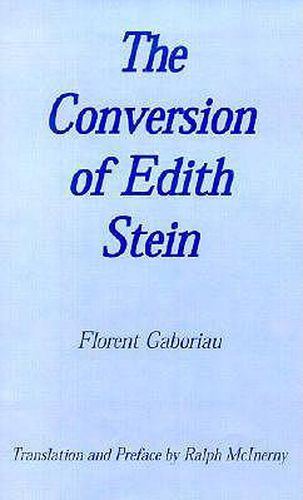Readings Newsletter
Become a Readings Member to make your shopping experience even easier.
Sign in or sign up for free!
You’re not far away from qualifying for FREE standard shipping within Australia
You’ve qualified for FREE standard shipping within Australia
The cart is loading…






One fateful day Edith Stein took from a friend’s bookshelf the autobiography of Saint Teresa of Avila. In it she found the simple truth about human existance. Shortly afterward, she became a Catholic, but her desire to become a Carmelite like Teresa was delayed for some time. Eventually whe entered the convent in Cologne. Because Nazi persecution of Jews, converted or not, she asked to be moved to a convent in the Netherlands. the German armies occupation soon followed. It was from the Carmelite convent of Echt that she was taken in 1942, shipped to Auschwitz and executed. Florent Gaboriau sees Edith Stein’s conversion under three aspects: first the conversion of a ‘Jew’ then the conversion of a ‘femenist’, finally the conversion of a ‘philosopher’. Stein saw her conversion as the fulfillment of herself as Jewish; she saw the uniqueness of woman in the light of faith; she saw her phenomenology as finding its home withn Christian philosophy. One of the most brilliant women of her generation, Stein became a model of sanctity. But her canonization by John Paul II was the occasion for strange reactions. Gaboriau’s account of her conversion puts it all into perspective.
$9.00 standard shipping within Australia
FREE standard shipping within Australia for orders over $100.00
Express & International shipping calculated at checkout
One fateful day Edith Stein took from a friend’s bookshelf the autobiography of Saint Teresa of Avila. In it she found the simple truth about human existance. Shortly afterward, she became a Catholic, but her desire to become a Carmelite like Teresa was delayed for some time. Eventually whe entered the convent in Cologne. Because Nazi persecution of Jews, converted or not, she asked to be moved to a convent in the Netherlands. the German armies occupation soon followed. It was from the Carmelite convent of Echt that she was taken in 1942, shipped to Auschwitz and executed. Florent Gaboriau sees Edith Stein’s conversion under three aspects: first the conversion of a ‘Jew’ then the conversion of a ‘femenist’, finally the conversion of a ‘philosopher’. Stein saw her conversion as the fulfillment of herself as Jewish; she saw the uniqueness of woman in the light of faith; she saw her phenomenology as finding its home withn Christian philosophy. One of the most brilliant women of her generation, Stein became a model of sanctity. But her canonization by John Paul II was the occasion for strange reactions. Gaboriau’s account of her conversion puts it all into perspective.